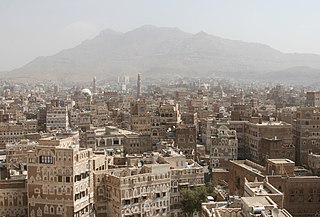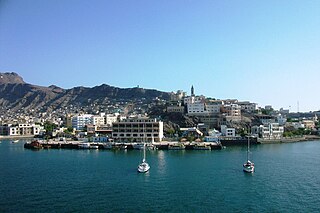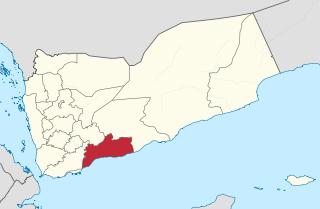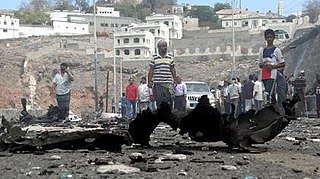
The Yemeni Armed Forces are the military forces of the Republic of Yemen. They include the Yemeni Army, Yemeni Navy and the Yemeni Air Force. The capital of the country, Sana’a is where the military is headquartered. Per the constitution of Yemen, the President of Yemen serves as the commander-in-chief.

The Houthi takeover in Yemen, also known as the September 21 Revolution, or 2014–15 coup d'état, was a popular revolution against Yemeni President Abdrabbuh Mansur Hadi led by the Houthis and their supporters that pushed the Yemeni government from power. It had origins in Houthi-led protests that began the previous month, and escalated when the Houthis stormed the Yemeni capital Sanaa on 21 September 2014, causing the resignation of Prime Minister Mohammed Basindawa, and later the resignation of President Abdrabbuh Mansur Hadi and his ministers on 22 January 2015 after Houthi forces seized the presidential palace, residence, and key military installations, and the formation of a ruling council by Houthi militants on 6 February 2015.

The following lists events that happened in 2015 in Yemen.

The Yemeni Crisis began with the 2011–2012 revolution against President Abdullah Saleh, who had led Yemen for 33 years. After Saleh left office in early 2012 as part of a mediated agreement between the Yemeni government and opposition groups, the government led by Saleh's former vice president, Abdrabbuh Mansur Hadi, struggled to unite the fractious political landscape of the country and fend off threats both from Al-Qaeda in the Arabian Peninsula and from Houthi militants that had been waging a protracted insurgency in the north for years.

The Battle of Sanaa in 2014 marked the advance of the Houthis into Sanaa, the capital of Yemen, and heralded the beginning of the armed takeover of the government that unfolded over the following months. Fighting began on 9 September 2014, when pro-Houthi protesters under the command of Abdul-Malik al-Houthi marched on the cabinet office and were fired upon by security forces, leaving seven dead. The clashes escalated on 18 September, when 40 were killed in an armed confrontation between the Houthis led by military commander Mohammed Ali al-Houthi and supporters of the Sunni hardliner Islah Party when the Houthis tried to seize Yemen TV, and 19 September, with more than 60 killed in clashes between Houthi fighters and the military and police in northern Sanaa. By 21 September, the Houthis captured the government headquarters, marking the fall of Sanaa.

The aftermath of the Houthi takeover in Yemen refers to developments following the Houthis' takeover of the Yemeni capital of Sana'a and dissolution of the government, which eventually led to a civil war and the Saudi Arabian-led intervention in Yemen.

Abdel-Aziz bin Habtour is a Yemeni politician who has been the Incumbent prime minister of Yemen since 4 October 2016. He also served as Governor of Aden during the Houthi takeover in Yemen. He is a member of the General People's Congress, sitting on its permanent committee since 1995. An ally of President Abdrabbuh Mansur Hadi, he condemned the 2014–15 Yemeni coup d'état and received the deposed leader after his flight from the Houthi-controlled capital of Sanaa on 21 February 2015. He is also a vocal opponent of the separatist movement in the former South Yemen, saying the movement is too fractured and small to achieve its goals.

The Battle of Aden was a battle for the control of Aden, Yemen, between Houthis rebels and Yemen Army forces loyal to Ali Abdullah Saleh on one side, and Yemen Army units loyal to Abdrabbuh Mansur Hadi and Southern Movement militias on the other side.
Major general Mahmoud al-Subaihi is a Yemeni military officer. He served in the cabinet of President Abdrabbuh Mansur Hadi as defence minister. In the Yemen Army, he holds the rank of major general. He was appointed to head the Ministry of Defence by Prime Minister Khaled Bahah in November 2014.
Al Anad Air Base is a military air base in the Lahij Governorate, Yemen. It is the biggest air base in Yemen.

Abdul-Hafez al-Saqqaf is a Yemeni military officer. A general in Yemen's Special Security Forces, al-Saqqaf achieved notoriety when he defied President Abd Rabbuh Mansur Hadi's decree to step down in March 2015, amid the aftermath of a coup d'état that split Yemen's government and military and saw Hadi establish a provisional seat of government in Aden.
The Battle of Dhale was a key fight for control of Dhale, Yemen, between the Houthis and Yemen Army units loyal to Ali Abdullah Saleh on one side, and militiamen and Yemen Army units loyal to Abd Rabbuh Mansur Hadi on the other side.

The Abyan campaign was a campaign for control of the Abyan Governorate of Yemen, between the Houthis and Yemen Army units loyal to Ali Abdullah Saleh on one side, and militiamen and Yemen Army units loyal to Abd Rabbuh Mansur Hadi on the other side, supported by jihadists of al-Qaeda in the Arabian Peninsula. The Pro-Hadi Forces recaptured the Abyan Governorate on 11 August 2015, after launching an offensive on pro-Houthi forces in early August.

The Shabwah campaign was a campaign for control of the Shabwah Governorate of Yemen, between the Houthis and Yemen Army units loyal to Ali Abdullah Saleh on one side, and militiamen and Yemen Army units loyal to Abdrabbuh Mansur Hadi on the other side. The offensive was also launched during a previously started AQAP offensive.

The Lahij insurgency was a guerrilla war in 2015 waged by tribesmen loyal to Abdrabbuh Mansur Hadi against the Houthis and Yemen Army units loyal to Ali Abdullah Saleh, who controlled most of the Lahij Governorate of Yemen. In late July, Pro-Hadi forces had launched an offensive to recapture Al Anad Air Base and rest of Lahij Governorate. On 4 August, Pro-Hadi forces had retaken full control of the Lahij Governorate.

The siege of Taiz is an ongoing, protracted military confrontation between opposing Yemeni forces in the city of Taiz for control of the city and surrounding area. The battle began one month after the start of the Yemeni Civil War.

The Aden unrest was a conflict between Islamist factions, such as al-Qaeda in the Arabian Peninsula, and Islamic State of Iraq and the Levant's Yemen Branch, against the loyalists of president Abd Rabbuh Mansur Hadi and later to conflict between UAE-backed and Saudi-backed factions within the coalition. In 2017, fighting also broke out between factions aligned with different members of the Saudi-led coalition namely Saudi Arabia-backed Abdrabbuh Mansur Hadi and Al-Islah and UAE-backed separatist Southern Transitional Council and Southern Movement.
In Yemen, popular committees are armed groups formed by Yemeni tribes on behalf of more professional armed forces.
The following is a timeline of the Yemeni civil war, which began in September 2014.
The Yemeni National Resistance is an elite formation of former members of the Yemeni Republican Guard and Central Security Organization commanded by Tareq Saleh, nephew of former Yemeni President Ali Abdullah Saleh, and loyal to the Hadi-led government fighting against the Houthi movement in the Yemeni Civil War.












